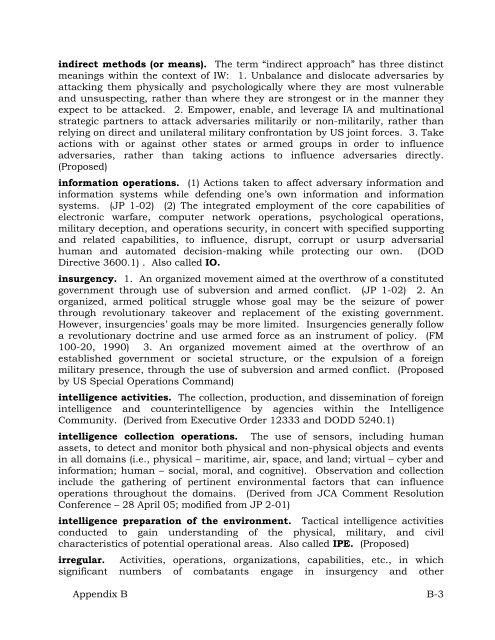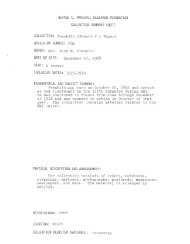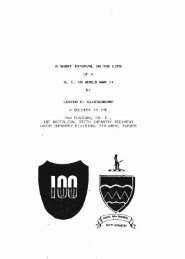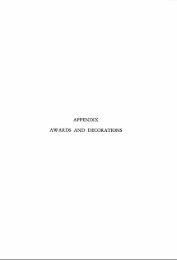Joint Operating Concept (JOC) - GlobalSecurity.org
Joint Operating Concept (JOC) - GlobalSecurity.org
Joint Operating Concept (JOC) - GlobalSecurity.org
Create successful ePaper yourself
Turn your PDF publications into a flip-book with our unique Google optimized e-Paper software.
indirect methods (or means). The term “indirect approach” has three distinct<br />
meanings within the context of IW: 1. Unbalance and dislocate adversaries by<br />
attacking them physically and psychologically where they are most vulnerable<br />
and unsuspecting, rather than where they are strongest or in the manner they<br />
expect to be attacked. 2. Empower, enable, and leverage IA and multinational<br />
strategic partners to attack adversaries militarily or non-militarily, rather than<br />
relying on direct and unilateral military confrontation by US joint forces. 3. Take<br />
actions with or against other states or armed groups in order to influence<br />
adversaries, rather than taking actions to influence adversaries directly.<br />
(Proposed)<br />
information operations. (1) Actions taken to affect adversary information and<br />
information systems while defending one’s own information and information<br />
systems. (JP 1-02) (2) The integrated employment of the core capabilities of<br />
electronic warfare, computer network operations, psychological operations,<br />
military deception, and operations security, in concert with specified supporting<br />
and related capabilities, to influence, disrupt, corrupt or usurp adversarial<br />
human and automated decision-making while protecting our own. (DOD<br />
Directive 3600.1) . Also called IO.<br />
insurgency. 1. An <strong>org</strong>anized movement aimed at the overthrow of a constituted<br />
government through use of subversion and armed conflict. (JP 1-02) 2. An<br />
<strong>org</strong>anized, armed political struggle whose goal may be the seizure of power<br />
through revolutionary takeover and replacement of the existing government.<br />
However, insurgencies’ goals may be more limited. Insurgencies generally follow<br />
a revolutionary doctrine and use armed force as an instrument of policy. (FM<br />
100-20, 1990) 3. An <strong>org</strong>anized movement aimed at the overthrow of an<br />
established government or societal structure, or the expulsion of a foreign<br />
military presence, through the use of subversion and armed conflict. (Proposed<br />
by US Special Operations Command)<br />
intelligence activities. The collection, production, and dissemination of foreign<br />
intelligence and counterintelligence by agencies within the Intelligence<br />
Community. (Derived from Executive Order 12333 and DODD 5240.1)<br />
intelligence collection operations. The use of sensors, including human<br />
assets, to detect and monitor both physical and non-physical objects and events<br />
in all domains (i.e., physical – maritime, air, space, and land; virtual – cyber and<br />
information; human – social, moral, and cognitive). Observation and collection<br />
include the gathering of pertinent environmental factors that can influence<br />
operations throughout the domains. (Derived from JCA Comment Resolution<br />
Conference – 28 April 05; modified from JP 2-01)<br />
intelligence preparation of the environment. Tactical intelligence activities<br />
conducted to gain understanding of the physical, military, and civil<br />
characteristics of potential operational areas. Also called IPE. (Proposed)<br />
irregular. Activities, operations, <strong>org</strong>anizations, capabilities, etc., in which<br />
significant numbers of combatants engage in insurgency and other<br />
Appendix B<br />
B-3
















